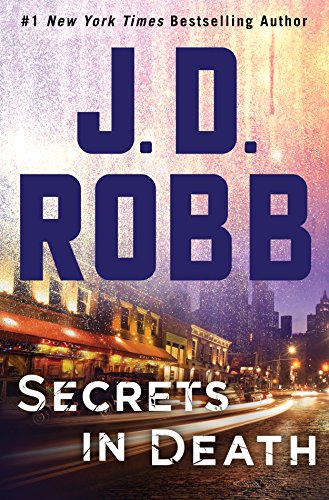Veteran puzzle editor Fred Piscop created the cryptic puzzles that will appear inside the jacket in the hardcover edition of Secrets in Death, on sale September 5, 2017. Below is a behind-the-scenes exclusive interview. Enjoy!

Veteran puzzle editor Fred Piscop created the cryptic puzzles that will appear inside the jacket in the hardcover edition of Secrets in Death, on sale September 5, 2017. Below is a behind-the-scenes exclusive interview. Enjoy!
“Cryptic clues always involve some sort of wordplay. Moreover, cryptic clues are usually divided into two parts: a straight definition and a bit of wordplay, both leading to the same answer word.”
SMP: Hi Fred, thank you so much for creating such terrific puzzles for Secrets in Death. How did you get started creating puzzles?
FP: I’ve been a puzzle person practically all my life. When I was eight years old, I was placed into an experimental program in which 4th through 6th grades were done in two years. My teacher for both years was George Bredehorn, who introduced me and the class to anagrams, word games, mathematical brainteasers and all sorts of other creative stuff. George and I remained close until his death in 2012. If not for George, I probably would never have gotten into the puzzle biz.
I started creating cryptics in the 1980s and conventional crosswords around 1990. Perhaps not surprisingly, I found that I was pretty good at it. I constructed puzzles part-time until I got laid off from my computer job. Since then, I’ve been a full-time puzzler.
SMP: How many puzzles do you think you have created?
FP: I estimate that I’ve created over 7000 puzzles so far.
SMP: Where else might people find puzzles you’ve created?
FP: My puzzles also appear in Newsday (Creators Syndicate) – in August my 1000th Newsday puzzle was published; The New York Times (I create a monthly bonus puzzle for online subscribers, and have taken over creation of Split Decisions, a variety word puzzle, following the death of its inventor, the aforementioned George); Crosswords with Friends (a new offering from Zynga, the folks who brought you Words with Friends – I’m proud to be part of that team); and several other outlets. And, I’m currently the editor of the USA Today Crossword.
SMP: How much math is involved in creating these puzzles?
FP: Interestingly, people who are good at math or music or both (I’m good at both) tend to be good at puzzles; while people who are literary (English majors and the like) tend not to be good at puzzles. Puzzle construction is mathematical in the sense that the constructor has to think in two dimensions and has to be cognizant of letter sequences that are more common than others, and letters that appear more commonly than others. A simple example: N is much more common in the alphabet than M, but if you look in a dictionary, you’ll see that the M section is four or five times as big as the N section. On the other hand, words end with N much more commonly than they do with M. So if you have a choice of starting a word with M or N, it makes mathematical sense to choose M – but the opposite is true with ending a word.
SMP: How do you come up with the clues for the puzzles?
FP: It’s an easy matter to just select clues from any of the massive databases out there, but I try to come up with original stuff when I can, using Google searches. Often I’ll find something interesting that I’ve never seen before. I recently clued ARM as “Tommy John surgery site.” It’s a fresh clue that I haven’t seen (not to say that it’s never been done).
SMP: With your love of puzzles, do you read mysteries?
FP: I don’t read mysteries, but I have contributed crosswords to several books in the “Puzzle Lady” mystery series, authored by Parnell Hall. You have to solve the puzzle to discover a quip that is relevant to the mystery.
SMP: So you created two puzzles for SECRETS IN DEATH, a Crossword and a Cryptic. They look the same, what’s the difference?
FP: Actually they don’t look the same at all. Conventional crossword diagrams are fully interlinked; every letter is contained by an across and a down word. But in a cryptic, only every other letter in a word is crossed. And the clues have different formats: conventional crossword clues are generally straightforward, while cryptic clues always involve some sort of wordplay. Moreover, cryptic clues are usually divided into two parts: a straight definition and a bit of wordplay, both leading to the same answer word. (You can learn more about cryptics from my book Cryptic Crosswords & How to Solve Them).
SMP: What surprised you most as you created the SECRETS IN DEATH puzzle and cryptic?
FP: Actually I surprised myself that the cryptic construction went so smoothly. I hadn’t constructed one in over 20 years.
SMP: So many people do crosswords to relax. What do you do to relax?
FP: I solve the cryptic in the Guardian (a British paper) every day. I do my best to stay in shape: run, bike, go to the gym and play senior softball. And I’m a musician too, a keyboard player. I play at a few jam sessions every week, but don’t really gig anymore. My favorite jam these days is on Tuesday night at Katie’s of Smithtown. The house band consists of world-class players including drummer Bobby Rondinelli, who has played with Black Sabbath, Blue Öyster Cult, Rainbow, Leslie West, and a host of others too numerous to mention here. And I take my niece’s dog Dina out for a long walk every day.
SMP: Thanks, Fred!


Where can I get a copy of these Secrets in Death puzzles? I don’t want to rip apart the glued-down jacket on my library book.
LikeLike
Hi Martha….check out Nora’s book store. They may have something there…….https://www.ttpbooks.com/SFNT.html
LikeLike